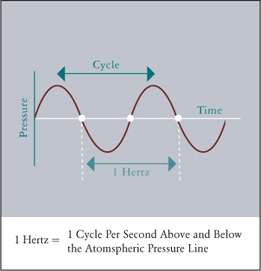What is Hertz?
Understanding Hertz is important for soundproofing. One complete oscillation of a sound wave is called a Cycle. Hertz simply measures the frequency of the cycle. One Hertz is the equal to one Cycle per second.

Cycles are also referred to as vibrations. The frequency of a sound wave refers to the number of cycles (vibrations) per unit of time. The standard measure of frequency is called a Hertz. One Hertz (Hz) equals one vibration per second. Human voice averages a frequency band of 1000 Hertz, or 1 kilohertz (kHz). This equals one thousand vibrations per second. The greater the number of cycles per second, the higher the frequency, the higher the pitch of sound. Audible sound sources to the human ear range from 20 to 20,000 Hertz. Sounds above this frequency are called “ultrasonic” while sounds below this frequency are called “infrasonic”.
Long Flat Sound Waves
When performing a soundproofing treatment, the pitch of the noise plays a key role in product selection. For lower pitched sounds with lower Hertz values, the wave lengths become longer and flatter, requiring less distance and time to travel through a surface. These are the more difficult sound sources to combat, and helps explain why you might be able to detect a neighbors bass tones from his stereo, but not human voice from his television. The following illustration compares a high pitched tone to a low pitched tone traveling through the same surface. Compare the distance traveled through this surface from both sound sources:
For your noise reduction treatment, take notice in advance as to the frequency of your noise source. If your soundproofing goal is to control reverberations using NetWell’s acoustic panels, thicker material will trigger stronger results if you have low bass tones. For example, suppose you want to line a drum booth with acoustic foam. By applying NetWell’s 3″ thick Pyramid foam panels instead of the 2″ thick panel, you will triple your absorption results at the low base end under 125 Hz. The reason? Because the long, flat sound waves produced by the drums are forced to pass through more material, giving the Pyramids more time and distance to capture the energy and convert it.
Back to Sound 101